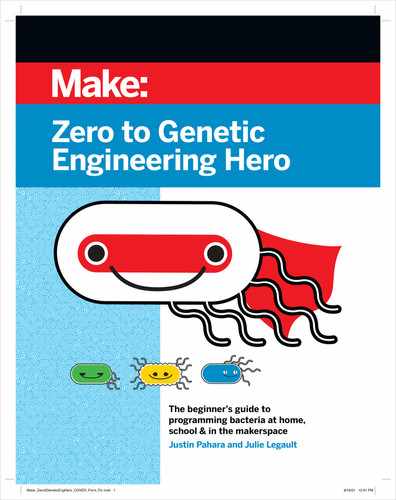
187Zero to Genetic Engineering Hero - Chapter 7 - Manually turning on genes in situ
5. When the right light is present and hits the CCaS
protein, the CCaS becomes active and can add a phos-
phate molecule (phosphorylation) to the CCaR protein.
This allows CCaR to bind to the pCpcG2-172 promoter
and activate gene expression.
6. The phosphorylated CCaR protein binds to a
promoter called pCpcG2-172 which activates expres-
sion of a sigma factor called CCG that is only able to
interact with the T7 RNA polymerase (Step 2) and
another promoter that is the non-coding region of
your color-producing gene.
7. Sigma CCG is expressed and completes the Four
B’s to ultimately interacts with the pCCG promoter
upstream of the pigment coding sequence. Upon bind-
ing to the pCCG promoter, sigmaCCG also binds to the
T7 RNA polymerase that was automatically created
in Step 2. This leads to transcription of the pigment
coding sequence, which is followed by translation and
folding of the pigment protein. The bacteria change
color!
8. Sigma CCG and T7 RNA polymerase start the Three
Steps to Microfacturing, and a pigment protein is
created.
2.
3.
4.
6.
7.
8.
5.
T
7
C
o
r
e
P
o
l
y
m
e
r
a
s
e
C
A
T
C
c
a
S
C
c
a
R
σ
C
C
G
C
o
l
o
r
G
e
n
e
P
P
1.
antibiotic resistance
a
u
t
o
m
a
t
i
c
a
l
l
y
e
x
p
r
e
s
s
e
d
a
u
t
o
m
a
t
i
c
a
l
l
y
e
x
p
r
e
s
s
e
d
t
u
r
n
e
d
o
n
b
y
C
c
a
R
t
u
r
n
e
d
o
n
b
y
C
C
G
a
u
t
o
m
a
t
i
c
a
l
l
y
e
x
p
r
e
s
s
e
d
pCpcG2-172
pCCG
Colour Protein
σCCG
CcaR
CcaS
T7 Core Polymerase
Figure 7-7. Light-it Kit. Explaining how ‘color activation’ works.
Book _genetic engineering hero-AUG2021.indb 187Book _genetic engineering hero-AUG2021.indb 187 8/18/21 12:03 PM8/18/21 12:03 PM

188 Zero to Genetic Engineering Hero - Chapter 7 - Manually turning on genes in situ
Summary
In this chapter, you engineered K12 E. coli with
DNA plasmids with genetic regulation that can be
controlled. While some of the plasmids’ genes were
similar to those used in previous experiments, like
the selection marker genes that automatically turned
on, each of the plasmids had a gene of interest that
was controllable by a different class of environmental
cue - chemical, temperature, and light.
A common theme is that some proteins can either
activate (turn on) or repress (stop) transcription.
A sigma factor that binds to the promoter region
recruits RNA polymerase (or T7 core polymerase) to
cause transcription activation to occur. Conversely,
a protein repressor bound to the operator prevents
transcription until it is removed from the operator.
In fact, during activation, sigma factors (also called
transcription factors) needed to be either created
naturally by the cellular genes, by the genes in the
plasmid you transformed the cell with, or through
chemical modication such as phosphorylation. In
each of these instances, the proteins then bound to
the promoter region to recruit polymerase. During
repression, a protein was ‘roadblocking’ the RNA
polymerase, and an inducer molecule was added
to the cells, which bound to the repressor, changed
its shape, causing it to no longer bind to the DNA
promoter. This allowed RNA polymerase to initiate
transcription.
You are now well versed in growing cells, genetic engi-
neering, extracting proteins, enzymatic reactions,
and understanding genetic regulations of DNA plas-
mids. Congratulations, Genetic Engineering Hero!
HERO
GENETIC
ENGINEERING
HERO
GENETIC
ENGINEERING
Book _genetic engineering hero-AUG2021.indb 188Book _genetic engineering hero-AUG2021.indb 188 8/18/21 12:03 PM8/18/21 12:03 PM
..................Content has been hidden....................
You can't read the all page of ebook, please click here login for view all page.
